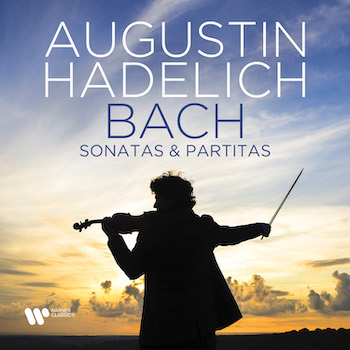Classical Album Review: Augustin Hadelich plays Bach
By Jonathan Blumhofer
The most striking thing about violinist Augustin Hadelich’s approach to these Bach pieces is his emphasis on the music’s dancing line.

The last quarter-century has been a good one for recordings of J.S. Bach’s six Sonatas & Partitas for unaccompanied violin. Hilary Hahn has recorded all of them. So have Christian Tetzlaff (twice), Julia Fischer, Miriam Fried, James Ehnes, Isabelle Faust, Alina Ibragimova, and Rachel Podger. Now comes Augustin Hadelich’s new account of the set.
The most striking thing about Hadelich’s approach to these pieces is his emphasis on the music’s dancing line. Fittingly, this is most consistently evident in his accounts of the three partitas.
In the B minor (no. 1), the “Allemande” features a nimbleness of articulation that’s captivating. So, too, the “Corrente” and “Bourée” (plus their respective “Doubles”), all of which offer a wonderful sense of character and shape. In them, Hadelich channels the music’s lilting spirit, playing with clarity and warmth of tone, tasteful embellishments on repeats, and plenty of heart (as his glassy, serene take on the “Sarabande” attests).
Much the same can be said for the E-major Partita (no. 3) — which features some of Hadelich’s fleetest, most invigorating playing on the album — as well as the first four movements of the D-minor Partita (no. 2). In the latter, the “Allemande” wants nothing for sweep, the “Corrente” and “Giga” whorl, and the “Sarabanda” shimmers like an oasis of repose: beautifully projected while weaving through a wide range of dynamics (many on the softer end of the spectrum).
Alas, the “Chaconne” impresses for textural clarity and tempo but doesn’t add up to the sum of its parts.
This isn’t necessarily an issue of speed: running a bit over 14 minutes, Hadelich’s reading is of similar pacing to Henryk Szeryng’s and Tetzlaff’s. However, his approach does blast through some of the “Chaconne’s” finer moments. It is conspicuously aggressive. The violinist’s articulations of the opening bars seem downright angry. Climaxes are forceful and even vehement.
True, the interpretation’s dynamic range is impressively nuanced and Hadelich shapes the first episode of arpeggios brilliantly. But his phrasing is sometimes choppy and, ultimately, the performance lacks a degree of structural and emotional grandeur. Hilary Hahn takes more time in it, but her account of the D-major apotheosis blazes and her cumulative reading packs a stronger expressive wallop.
Similar issues arise here and there in Hadelich’s performances of, especially, the First and Third Sonatas.

At times, Hadelich channels the music’s lilting spirit, playing with clarity and warmth of tone.
In the G minor (no. 1), he offers impressively clean and precise fingerwork over the first two movements, but a habit of exaggeratedly breaking consecutive triple and quadruple stops undercuts much of the music’s momentum. The third proves likewise choppy. Only in the blistering finale — taken at breakneck speed — does everything come together.
As for the C-major Sonata (no. 3), there are some wonderful moments, particularly in the amiable free episodes of the fugue; during Hadelich’s ravishing take on the slow movement; and throughout his spectacular, playful account of the finale.
But the first two movements are too-often punchy. Downbeats are overemphasized in the opening one and the reappearances of the fugue subject come over severely (again, the triple and quadruple stops are attacked aggressively).
The A-minor Sonata (no. 2), on the other hand, is elegant and songful throughout. Hadelich plays the opening movement with rich-toned focus, the fugue is magnificently shaped, and the latter movements overflow with vim. In other words, this Sonata dances just like the partitas; when that happens in this recording, all is well and right.
Jonathan Blumhofer is a composer and violist who has been active in the greater Boston area since 2004. His music has received numerous awards and been performed by various ensembles, including the American Composers Orchestra, Kiev Philharmonic, Camerata Chicago, Xanthos Ensemble, and Juventas New Music Group. Since receiving his doctorate from Boston University in 2010, Jon has taught at Clark University, Worcester Polytechnic Institute, and online for the University of Phoenix, in addition to writing music criticism for the Worcester Telegram & Gazette.
